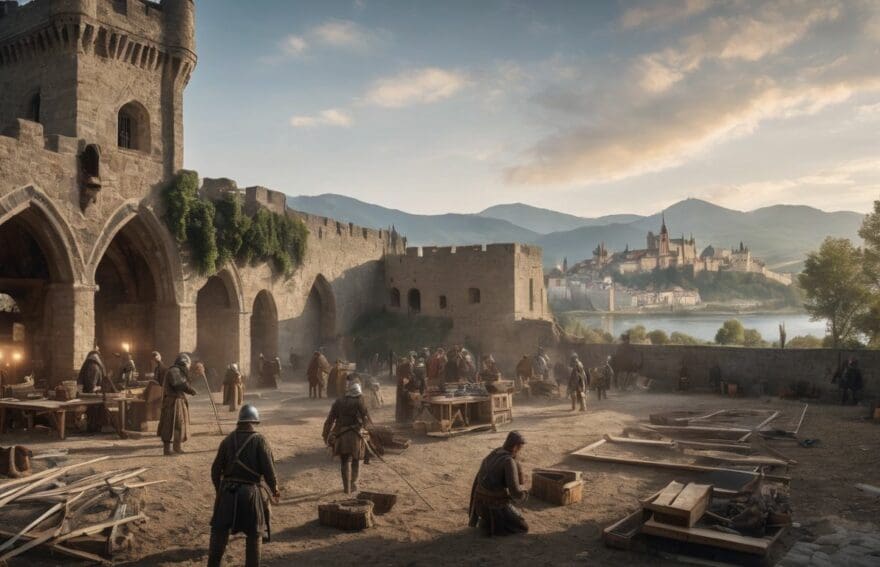Medieval Engineers: Constructing and Destroying Medieval Fortresses

Updated On: October 25, 2025 by James Connolly
Are you struggling with building and defending your medieval fortresses in the game Medieval Engineers? As fellow gamers, we understand the challenges of constructing and protecting strong fortifications. With our in-depth research, we have uncovered strategies for creating formidable castles and tactics for withstanding sieges. In this article, we will share our insights on building and destroying medieval fortresses to help you become a master engineer in the game. Get ready to level up your construction skills!
Overview of Medieval Engineers
Medieval Engineers takes us back to the times when castles dotted the landscape, and siege warfare was the order of the day. We delve into a sandbox world where creativity meets historical engineering, constructing everything from simple homes to grand fortresses using techniques that defined medieval architecture.
The game’s engine breathes life into our visions, crafting with voxel-based precision that brings even the smallest stone detail into sharp focus.
We immerse ourselves in a planetoid devoid of water yet rich with possibilities for landscaping and underground mining. As we build our architectural wonders, we rely on medieval technology for both creation and destruction.
Designing defensive structures demands thoughtful resource management while mechanical devices like catapults await our command to lay siege against formidable walls. Engaging in this virtual world of fortress construction and castle siege not only hones our skills but also showcases structural masterpieces born from collaboration or individual prowess alike.
The game’s focus on construction and destruction
We revel in the dual thrill of building and tearing down in Medieval Engineers, pushing our creativity to its limits. Erecting grand fortresses with meticulous attention to mediaeval construction techniques tests our skill as architects.
Each block placement is a step back into history, where we learn not only about castle design but also the intricate mechanics behind hoists and drawbridges.
Our efforts don’t stop at creation; destruction holds equal weight in this sandbox game. We strategise siege attacks, aiming catapults and trebuchets to bring down enemy walls crafted by fellow players or AI foes.
Every demolished stone feels satisfyingly realistic thanks to the detailed voxel-based system that captures every crack and crumble of the battle-worn structures we both defend and dismantle.
Building Medieval Fortresses
We will discuss strategies for constructing strong fortifications, using mechanical devices and engines to aid in construction, and landscaping and underground mining for resources.
If you want to learn more about building medieval fortresses in Medieval Engineers, keep reading!
Strategies for constructing strong fortifications
To construct strong fortifications in Medieval Engineers, we must employ the following strategies:
- Utilise strategic placement of walls and towers to create layers of defence, making it harder for attackers to breach the fortress.
- Employ defensive landscaping and underground mining to gather resources for construction and strengthen the fortress’s foundations.
- Leverage mechanical devices and engines for efficient construction, such as cranes for lifting heavy materials and pulley systems for transportation.
- Implement advanced fortification designs using medieval engineering principles, incorporating features like battlements, arrow loops, and drawbridges to enhance defence mechanisms.
- Use historical knowledge of medieval warfare and fortification design to create realistic and effective structures that withstand attacks from siege weapons.
Using mechanical devices and engines to aid in construction
To complement the construction of strong fortifications, players can utilise various mechanical devices and engines to aid in the building process. This allows for more efficient and effective construction techniques. Here are some ways players can utilise mechanical devices and engines in Medieval Engineers:
- Mechanised Cranes: Players can employ mechanised cranes to lift heavy building materials, making it easier to construct large and sturdy fortresses.
- Pulley Systems: Utilising pulley systems can assist in lifting and transporting resources to different parts of the fortress, enabling more strategic placement of materials.
- Water Wheels: Incorporating water wheels into the fortress design can help generate power for various construction tasks, such as milling lumber or operating other machinery.
- Windmills: Harnessing wind energy with windmills can provide an additional source of power for specific construction needs, offering sustainability in resource management.
- Steam Engines: Implementing steam engines can offer increased efficiency in powering essential tools and machines required for complex construction projects within the fortress.
- Conveyor Belts: Constructing conveyor belts around the fortress site aids in the transportation of resources across different areas, optimising logistics and resource management.
Landscaping and underground mining for resources
In Medieval Engineers, players can modify the landscape to gather resources and build their fortresses. They can engage in underground mining to extract vital materials for construction and weaponry. Here are some strategies for landscaping and underground mining:
- Using terrain manipulation tools to shape the environment and create suitable locations for mining operations.
- Employing advanced digging techniques to access underground resources such as stone, iron, and coal.
- Establishing efficient pathways and tunnels for resource transportation within the fortress.
- Implementing proper reinforcement to prevent cave – ins during mining activities.
- Utilising geological surveys to identify potential resource-rich areas for excavation.
- Adhering to sustainable mining practices to minimise environmental impact while extracting resources.
- Incorporating natural elements into fortress design by integrating landscape features like hills and rivers into defensive strategies.
- Developing irrigation systems for agricultural purposes, maximising the use of natural resources in fortress development.
- Constructing protective barriers around resource deposits to safeguard them from enemy raids or sabotage attempts.
- Strategically planning resource extraction activities based on proximity to potential threats and accessibility for trade routes.
Defending Against Attacks
Designing fortresses to withstand attacks is crucial in Medieval Engineers. Building defences such as walls, towers, and traps can help protect your stronghold from enemy assaults.
Designing fortresses to withstand attacks
When designing fortresses to withstand attacks, consider the following strategies:
- Strategically placing defensive structures such as towers and walls to create a strong perimeter that is difficult for attackers to breach.
- Incorporating natural landscape features, such as cliffs or bodies of water, into the fortress design to provide additional protection and make it harder for enemies to approach.
- Constructing multiple layers of defence within the fortress, including inner walls, gates, and obstacles that force attackers to navigate through a series of barriers.
- Utilising hidden passageways and secret rooms within the fortress to allow defenders to move discreetly and launch surprise counter-attacks against invaders.
- Implementing defensive mechanisms such as traps, moats, and drawbridges that can hinder enemy advances and provide opportunities for defenders to repel assaults effectively.
- Ensuring that the fortress has adequate supplies of food, water, and other provisions to withstand prolonged sieges and maintain the morale of its inhabitants.
- Building lookout towers and guard posts equipped with ballistae or archers to provide early warning of enemy movements and target hostile forces from a distance.
- Incorporating sturdy construction materials and techniques into the fortress’s design to increase its resilience against various forms of attack.
- Establishing communication networks within the fortress to enable coordinated defence efforts and facilitate strategic responses to different types of threats.
Building defences such as walls, towers, and traps
To defend against attacks in Medieval Engineers, players can create formidable defences to protect their fortresses and cities. Utilising strategic placement and sturdy construction, a variety of defensive structures can be implemented to thwart enemy offensives. Here are some key defences to consider:
- Erecting strong stone walls around the perimeter of the fortress, providing a solid barrier against attackers.
- Constructing towering watchtowers along the walls, allowing for enhanced visibility and archer positions to repel invaders.
- Installing intricate traps such as pitfall traps or spike barriers to surprise and hinder hostile forces.
- Building reinforced gates with mechanisms for opening and closing, controlling access points and safeguarding entryways.
Siege Warfare
Using powerful siege weapons like catapults and trebuchets, players can lay siege to enemy fortresses and employ tactics to breach walls and break through defenses. Discover the thrill of medieval warfare as you engage in epic battles to conquer or defend mighty castles.
Using catapults, trebuchets, and other siege weapons to destroy fortresses
- Catapults: These war machines hurl heavy projectiles at high velocity, capable of inflicting widespread damage to fortress walls and structures.
- Trebuchets: With their ability to launch massive projectiles with precision, trebuchets offer a potent means of breaching fortified defences from a distance.
- Ballistae: These large crossbow-like weapons are effective for raining down barrages of arrows on enemy fortifications, creating chaos and weakening defensive positions.
- Siege Towers: These towering structures enable troops to breach high walls by providing a platform for attackers to gain access to the fortress interior.
- Battering Rams: These specialised vehicles are designed for battering down gates and doors, allowing for direct entry into the heart of enemy fortresses.
- Siege Cannons: Powerful cannons capable of blasting through thick fortress walls, causing devastation and opening up new avenues for invasion.
- Ladders and Grappling Hooks: Essential tools for scaling fortress walls and gaining access to elevated positions within the stronghold.
Tactics for breaching walls and breaking through defences
After learning about using catapults, trebuchets, and other siege weapons to destroy fortresses, let’s explore some tactics for breaching walls and breaking through defences. Here are some strategies to consider:
- Ramming: Use a battering ram to apply force against the fortress gates or walls, aiming to weaken or break them down.
- Sapping: Dig tunnels under the fortress walls to undermine their foundations, causing them to collapse.
- Scaling: Utilise ladders, ropes, or siege towers to gain access to the top of the walls and breach the defences from above.
- Mining: Place explosives or other devices at the base of walls to create breaches in the fortifications.
- Overwhelming force: Coordinate simultaneous attacks from different directions to disperse and overwhelm defenders.
- Fire-based tactics: Employ flaming projectiles or oil-soaked materials to set fire to wooden structures within the fortress and create chaos.
- Psychological warfare: Use intimidation tactics such as loud noises, psychological pressure, and propaganda to weaken defenders’ morale.
- Infiltration: Sneak spies into the fortress or use disguises to deceive the defenders and open gates from within.
The Importance of Resource Management
Gathering and managing resources is crucial for building and defending fortresses in Medieval Engineers. Players will need to utilise technology and crafting to create stronger defences and weapons, as well as maintain a balance between resource gathering and construction.
Gathering and managing resources for building and defending fortresses
To construct and defend fortresses in Medieval Engineers, resource management is vital. Players can gather materials such as wood, stone, and metal to build and fortify their structures. Additionally, managing food supplies is crucial for the sustenance of the fortress inhabitants. To maintain a robust defense, players must strategically allocate resources for weapon production and maintenance. Furthermore, careful management of manpower is essential to ensure efficient construction and defense operations. Without proper resource management, the fortress may be vulnerable to attacks and lack the necessary provisions for survival.
Utilising technology and crafting to create stronger defences and weapons
- Research and develop advanced defensive structures, such as reinforced gates and arrow slits, to bolster fortress defences.
- Utilise medieval weaponry blueprints to forge powerful siege weapons like ballistae and battering rams for offensive capabilities.
- Refine metalworking techniques to create durable armour and weapons for the fortress defenders, enhancing their combat readiness.
- Innovate with engineering designs to construct sophisticated traps and deterrents, adding layers of protection to the fortress perimeter.
- Access historical building knowledge to replicate accurate medieval architectural features, optimising defensive capabilities.
Conclusion
In conclusion, Medieval Engineers provides players with a unique opportunity to explore the construction and destruction of medieval fortresses. The game’s focus on historical accuracy and engineering principles offers an immersive experience for those interested in medieval warfare and architecture.
Emphasise the importance of balance between construction and destruction in the game
Building and defending medieval fortresses in Medieval Engineers requires a delicate balance between construction and destruction. While constructing robust fortifications and mechanical devices is crucial for defence, understanding siege warfare tactics and the destructive power of siege weapons is equally important.
Players must carefully manage resources for building and defending while also considering the potential destruction of their structures during enemy attacks.
Striking this balance adds a layer of complexity to gameplay, creating an immersive experience that challenges players to think strategically about both construction and destruction aspects.
Encourage players to try out different strategies for building and defending fortresses.
Experimenting with various building and defensive tactics can lead to exciting discoveries in Medieval Engineers. By trial and error, players can uncover the most effective ways to construct sturdy fortresses and defend them against attacks.
The game’s realism and challenge provide an opportunity for both novice and expert gamers to test diverse strategies, embracing the creativity inherent in medieval construction and warfare.
With unlimited building options and historical accuracy underpinning the gameplay, players can immerse themselves in a world where engineering principles come alive. Try out different combinations of fortification methods, siege techniques, mechanical devices, and architectural designs to find the perfect balance between formidable defense and strategic offense.
FAQs
1. What skills did medieval engineers use in castle construction?
Medieval engineers applied mechanical engineering knowledge to build strong castles and city fortifications for defense.
2. How were medieval fortresses constructed?
Castle construction involved careful planning and skilled craftsmanship, using stone and other durable materials to create imposing structures designed for both living and defense.
3. Why was destroying enemy castles important in medieval times?
Destroying an opponent’s castle was a key tactic in warfare, as it weakened their defenses and asserted control over their territory.
4. Did medieval engineers only focus on building or did they also plan how to break down castle walls?
Medieval engineers not only focused on the art of constructing robust fortresses but also developed strategies for effective castle destruction during sieges.









